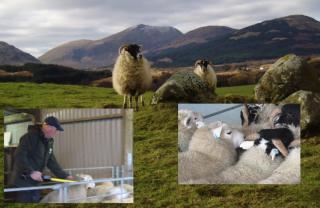Electronic Identification as a tool for Precision Livestock Management
Published on 24 March 2014 in Sustainability and Communities , Food, health and wellbeing

Introduction
Electronic Identification (EID) of livestock can be seen as burdensome for farmers; however it can present a fantastic opportunity to improve their management.
The aim of this brief is to present some ideas on how to use EID as a management tool in beef and sheep systems, based on research, demonstration and knowledge exchange activities conducted by research staff at SRUC’s Hill & Mountain Research Centre, Kirkton and Auchtertyre research farms.
Electronic Identification (EID) of livestock is based on Radio Frequency Identification (RFID). It can be used in either an ear tag, a bolus in the stomach, or as a microchip implanted under the skin. In the early 1980s EID was introduced into livestock farming and since then has been increasingly used as a farm management tool. There are different types of EID, with low frequency being the most common in the livestock industry.
Compulsory electronic tagging in the sheep industry was introduced in 2010 for breeding animals over 12 months old. For younger slaughter animals, regulations vary between Scotland and the rest of the UK, with Scotland requiring an electronic tag. Despite it often being seen otherwise, there is the potential for farmers to see the technology as an opportunity, which is what SRUC research staff are working to demonstrate.
Key Points
Ease of data collection - the technology only requires a reader and the electronic eartag number embedded in the chip. Reading the tag gives access to all the stored information relating to that particular animal.
Speed of animal handling and labour savings – using the technology greatly reduces handling time. At present, with a properly calibrated weigher/shedder, up to 500 animals per hour can be weighed and simultaneously sorted.
Accuracy of data collection – The information recorded and stored on the reader is more accurate than using pen and paper, with fewer opportunities for errors to occur. Once recorded and stored, the information can be easily transferred for further use.
New opportunities for animal management – On larger, more extensive farms, management can potentially be altered and positively enhanced. This offers a major opportunity for farmers to improve productivity, animal welfare and efficiency of their system.
Health and safety for staff – The safety of staff involved in animal handling can be put at risk whilst reading tags or sorting animals. Using an automated shedder or weigher could reduce such risks.
Research Undertaken
Part of the research ongoing at SRUC’s research hill farms at Kirkton and Auchtertyre farms, near Crianlarich, is focused on investigating the potential of using electronic identification in automated livestock management as a tool of Precision Livestock Farming, where each individual animal is considered, and so more precise changes can be made improving productivity overall.
Supported by the Scottish Government’s research programme, the research team is investigating the potential uses, benefits and issues of sheep data collection with a fixed tag reader on a weigh crate, (large scales which the animals are taken to and weighed). The researchers are also studying data collection using a handheld electronic device; and auto-sorting of animals for ease of handling and labour saving on farm. A targeted approach to winter feeding of the animals, based on individual weight change recorded using this system, is also being trialled and tested.
Sheep are showing greater resistance to anthelminthics, which are used to treat worms. In collaboration with Moredun Institute, a Targeted Selective Treatment approach for lamb worming, based on individual animal weight change as assessed by EID, is also being tested under hill farm conditions. In addition, the team is investigating how the technology can support data collection for EBVs (Estimated Breeding Values) in hill sheep.
Potential links to abattoir data collection are also being researched, as a means for farmers to obtain more accurate feedback on the animals being sent to slaughter, on an individual basis.
Questionnaires at agricultural shows have also been carried out to gauge farmers’ interest and understanding of the technology for management purposes. Further activities and demonstration at open days and visits to the research hill farms are also on-going, to show farmers the potentials of this technology in practice.
Policy Implications
Specific considerations of this research so far are:
- The costs of the weigh crate and automatic shedder is a potential barrier to uptake by farmers. Having aid towards the purchase of technology in some of the SRDP/LMC options could be a useful way to encourage uptake by the hill farming community. Having a ‘sharing scheme’ (like a machinery ring) for the weigh crate could be a solution, perhaps with advisory service staff helping to coordinate and run the scheme.
- Combining the use of electronic identification with data collection for genetic improvement (EBVs) could encourage hill farmers to make better use of the available technology to improve animal performance and, thereby, farm efficiency and profitability.
- Face-to-face training and support, as well as on-farm demonstration on how to use the technology, are means of information dissemination that are valued by farmers. These methods should be supported to encourage uptake.
Authors
Dr Claire Morgan-Davies, SRUC claire.morgan-davies@sruc.ac.uk
Dr Christina Umstatter christina.umstatter@sruc.ac.uk
Topics
Sustainability and Communities , Food, health and wellbeing







